What makes the perfect escape?

Burying our heads in a book and our toes in a beach offers escape from frantic working lives for many of us. Yet, when it comes to some of the world’s most beautiful escapist getaways, from hotels and private villas to entire resorts, a complex, multisensory raft of factors come into play.
More like this:
– The ancient enigma that resonates now
– Inside the ethical beauty boom
– How to be a sustainable fashion lover
Storytelling is the buzzword in interiors for creating spaces that imaginatively reference a venue’s location and history, giving it a unique atmosphere. For guests, such decors draw attention to the venue’s interesting past, overtly or subliminally, and make their stay more memorable.
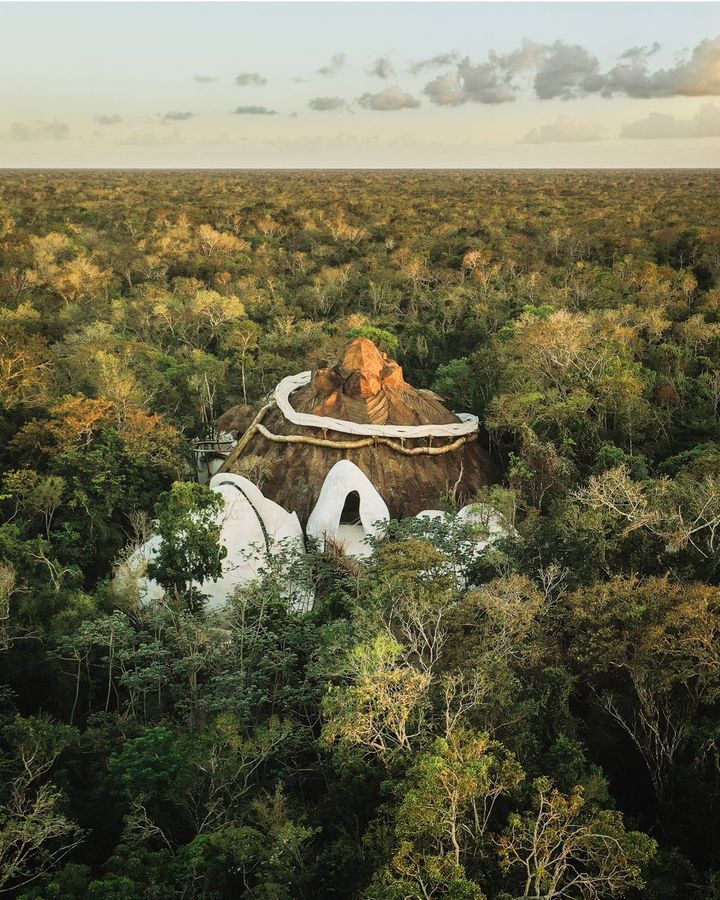
A new book More Escapism explores some of the most beautiful retreats around the world (Credit: Courtesy Azulik)
Storytelling was a central concern for interior design firm Champalimaud Design when remodelling the interior of Troutbeck Hotel in New York’s Hudson Valley, a former inn with historical and literary associations. “We preserved the house’s historic aspects, including its stained-glass windows and original fireplace,” says Ed Bakos of Champalimaud. “Many of the fabrics used for the furnishings were collected over years. The idea is for guests to feel completely at home in a layered place they can wander around and discover.”
Escapist getaways can also include creative, witty touches that depart from historical authenticity. These can still deepen guests’ connection to them – and boost their wellbeing. According to Pauline Sheldon, professor at the University of Hawaii, “Wellness includes an aliveness connected to creativity. In the design of spaces, a surprise element is important. Something that sparks a sense of wonder or awe and brings the visitor to the present moment is mentally calming.”
Surprise elements abound in the projects of California-born interior designer and landscape architect Bill Bensley, whose maximalist maxim is “If it’s worth doing, it’s worth overdoing”. After studying urban design at Harvard, he founded his studios in Bangkok and Bali in 1989 and 1990 respectively. His new book More Escapism: Hotels, Resorts and Gardens showcases 12 of his projects in Cambodia, Thailand, Vietnam, Indonesia and Laos. One of these – beach resort JW Marriott Lamarck University in Phu Qoc, Vietnam – riffs off its former incarnation as a university (named after French naturalist Jean-Baptiste Lamarck).
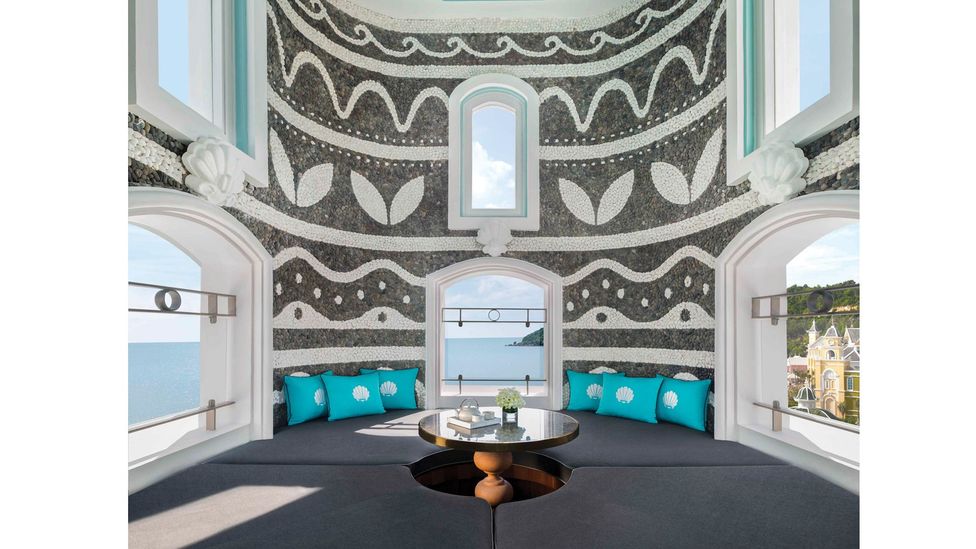
The designer of the Lamarck channelled the spirit of the former university campus in a playful way (Credit: Courtesy JW Marriott Phu Qoc)
Writing about it in his book, Bensley says: “I don’t like big hotels – who does? So what’s a designer like me do? I figured I needed to invent a culture, break the scale of a big hotel into a series of small ones and create a place to make people laugh – why do hotels have to be so serious? I wrote an elaborate script that includes a history of each building: when it was built and for what purpose. I live by the idea that a hotel should be like a movie, have a plot that makes it worth watching more than once.”
In the event, he channelled the spirit of the former university campus in a playful, visually entertaining way, full of eye-catching details. He named several of its buildings after university departments, such as the “department of physical education” (spa and gym) and the “department of chemistry” (beach bar). Hallways display original etchings of natural studies, some dating back to 1760. “For two years, we collected some 3,000 antiques and vintage pieces to give the university authenticity,” he says. These include a 19th-Century elevator, school bells arranged on the reception desk and sporting trophies cluttering a monumental storage unit. “We try to dive into local history as much as possible, and draw from it,” says Bensley.
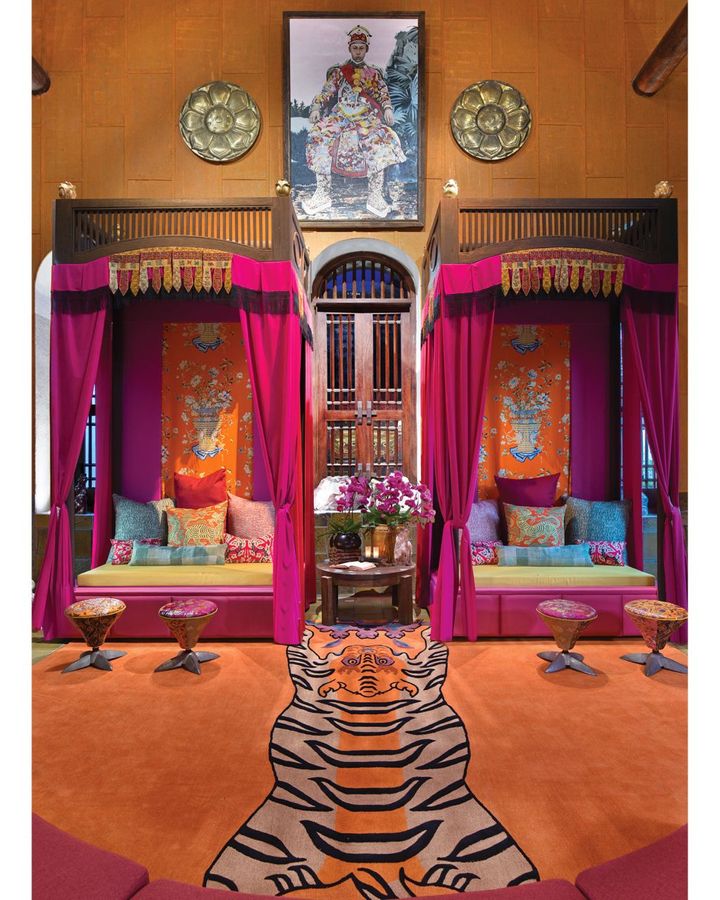
There is a sense of history in many of the retreats designed by Bill Bensley (Credit: Courtesy MGallery Hotel de la Coupole)
And Bensley admits that designers can fall into the trap of over-theming interiors to stultifying rather than inspiring effect – a theme-park look is best avoided, and is “the challenge with a strong narrative”.
One antidote to predictable interiors are unexpected, surreal elements, a hallmark of many escapist getaways. At another Bensley project, Shinta Mani Wild, a luxury camp in Cardamom Forest, Cambodia, an antique rocking horse suspended above the bar appears to fly through the space – a wingless Pegasus perhaps. Elsewhere armchairs and bookshelves crammed with books offer guests the opportunity to escape into the worlds of novelists or poets.
Natural remedy
Another key characteristic of ultra-escapist getaways is their proximity to nature. “Tourists today want to connect with local regions through their senses. They seek out spaces that bring nature inside – green, planted walls, flowing water, pleasant, natural aromas,” says Sheldon. “There’s a restaurant in Slovenia where the tables have living planted herbs for diners to pluck and enjoy. One critical element that is often forgotten is fresh air – the ability to breathe deeply without pollutants and air-conditioning is important to wellness.”
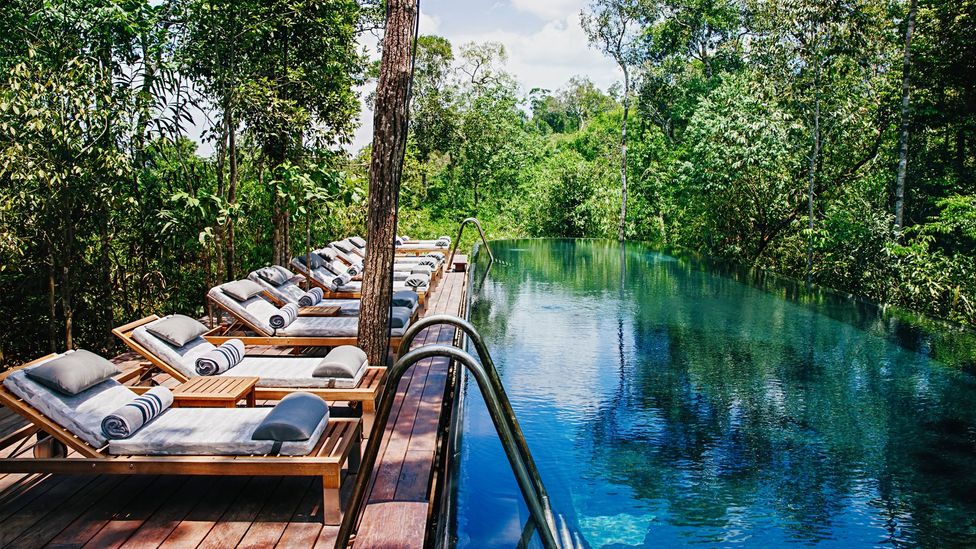
Shinta Mani is located in the rainforest, and fully immerses visitors in the natural setting (Credit: Courtesy Bill Bensley)
Shinta Mani Wild’s bar is a structure with a roof but no walls, its parameters informally defined by a ruggedly raw boulder on one side, as well as panoramic jungle views. The resort is located in one of South East Asia’s last unfragmented rainforests, and fully immerses visitors in nature. Asked what he requires from a truly escapist bolthole, Bensley says, “True wilderness – my favourite escape” and “No wifi (or at least very limited)”. In his book, he points out that Shinta Mani Wild’s attractions include sounds emanating from the forest, from a thunderous, fast-flowing waterfall to serene birdsong. “Rhythmic sounds, including crashing waves, enhance wellness,” says Sheldon. “These can still a busy mind, although best of all is silence. But silence shouldn’t be enforced.”
Shinta Mani Wild doesn’t deprive its guests of creature comforts though. A tent housing a restaurant looks like it’s been parachuted into an impenetrable forest, except that its décor is maximalist, sybaritic and playful. There are stylish table settings with wine glasses and banquettes covered in a camouflage fabric, gleefully described by the room’s interior designer as “camp”. A jungle-facing daybed seems to invite post-prandial contemplation of the tropical wilds. In Bensley’s world, natural settings and luxurious furnishings aren’t deemed incompatible.
Hong Kong-based interior designer André Fu, meanwhile, has capitalised on the tranquility of nature at his project, Hotel The Mitsui in Kyoto. “I worked with Kyoto landscape master Shunsaku Miyagi to create a Japanese garden that fosters calm through flowers, grasses, water and breezes… A water pool outside the hotel’s tea lounge provides a visual reflection of the landscape beyond. I like to design immersive environments that feel present and emotionally connected to their surroundings through scents, floristry and music.”
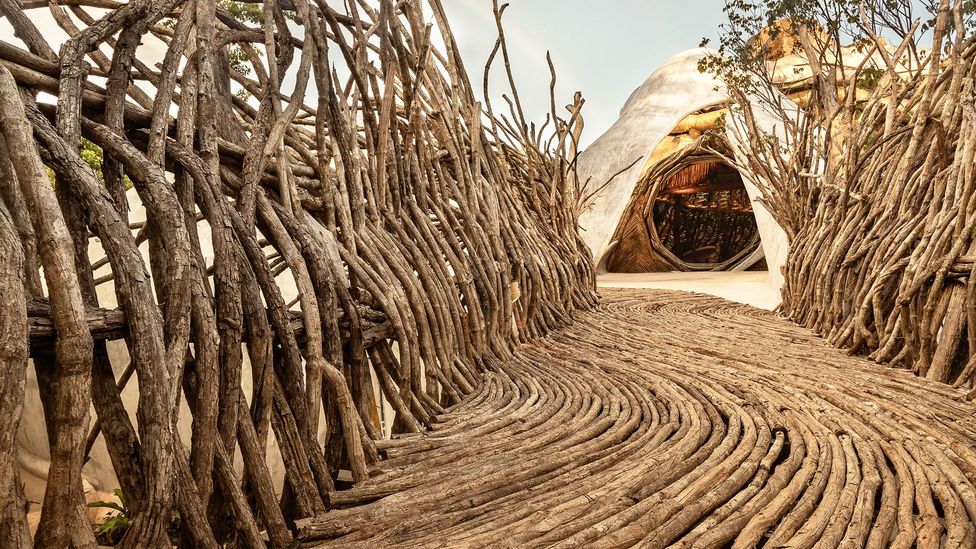
The environmentalist complex Azulik Uh May in Mexico has walkways made of indigenous, vine-like bejuco wood (Credit: Courtesy Azulik)
For some, the impulse to retreat to nature seems to answer a profound, atavistic need to recognise they are part of the natural world. “We’ve distanced ourselves from nature and its wisdom,” says Eduardo Neira, known as Roth, founder of Azulik Uh May, an environmentalist complex of villas rising above the jungle on the Yucatán Peninsula, Mexico. The villas are uncompromisingly organic in shape, with curved concrete and fibreglass walls and trees growing through the floor. They’re linked by walkways made of indigenous, vine-like bejuco wood.
“When architectural structures follow the pattern of surrounding environment in a consistent, organic way, it helps people to reconnect with nature, which we humans are a part of,” says Roth. The project chimes with the current trend for biophilic design, which incorporates nature – through water, trees, plants, light and natural ventilation – into architecture, in the interests of environmentalism, biodiversity and wellness.
Biophilia is also influencing escapist homes. A desire to connect with nature was the main inspiration behind a holiday home in Ibiza, with new interiors designed by architect and designer Natalia Miyar. “My clients, a London couple, bought a contemporary house in countryside facing the sea as a luxurious retreat from their busy lives,” she says. “Our brief was to create a stylish, modern villa filled with warmth, anchored by organic shapes and colours in tune with the Balearic setting. We softened the building’s modern architecture, using a palette of texture and pattern that combined warm hues with accents of vibrant turquoise that references the sea. Wherever possible, we chose natural materials and finishes – tumbled stone, rough edging and cane furniture – over ones with sharp, clean lines to achieve a rustic feel that connects the house with the outdoors. This has a calming effect.” The house has retractable, floor-to-ceiling windows designed to connect a terrace seamlessly with the living room. “Everything we chose helps bring the natural, exterior palette indoors,” adds Miyar.
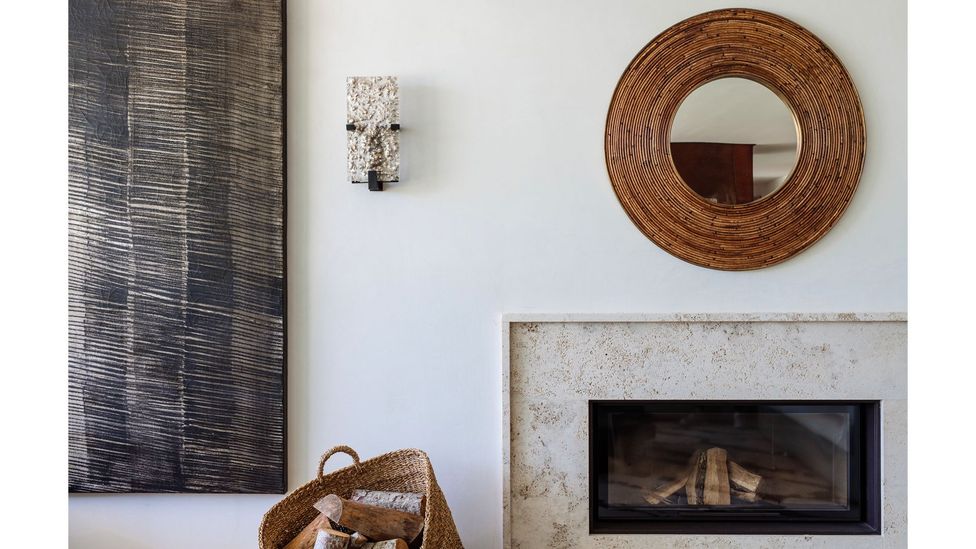
The soft palette and textures in the décor of this Ibiza home create a calm mood (Credit: Natalia Miyar)
According to Sheldon, the use of natural materials is paramount when creating escapist getaways that also prize wellness: “Natural building materials, especially those that reflect the natural environment in the region, establishing a sense of place, are to be welcomed. The overall focus when promoting wellness needs to be on nature, which holds the clue to our wellness much more than something we can dream up.”
Even so, in today’s escapist getaways, the artificial and natural, actual history and myth are often intertwined. There is no set formula for the perfect retreat: it can be a construct with artificial features designed to fire the imagination – or a space embracing nature, allowing the mind to disconnect from all mundane concerns.
More Escapism: Hotels, Resorts and Gardens by Bill Bensley is published by Thames & Hudson.
If you would like to comment on this story or anything else you have seen on BBC Culture, head over to our Facebook page or message us on Twitter.
And if you liked this story, sign up for the weekly bbc.com features newsletter, called The Essential List. A handpicked selection of stories from BBC Future, Culture, Worklife and Travel, delivered to your inbox every Friday.








